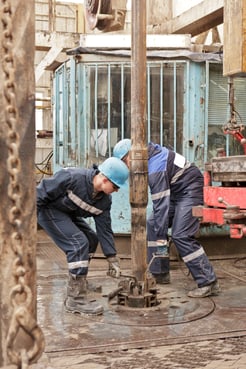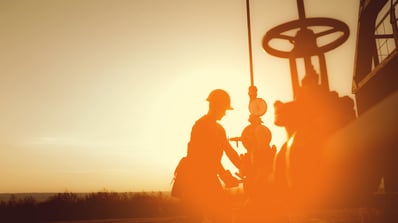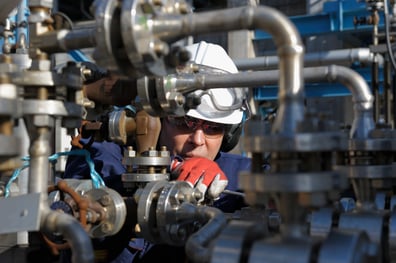Blackline Safety is a technology leader driving innovation in the industrial workforce through IoT (Internet of Things). With connected safety devices and predictive analytics, Blackline enables companies to drive towards zero safety incidents and improved operational performance. Blackline provides wearable devices, personal and area gas monitoring, cloud-connected software and data analytics to meet demanding safety challenges and enhance overall productivity for organizations with coverage in more than 100 countries. Armed with cellular and satellite connectivity, Blackline provides a lifeline to tens of thousands of people, having reported over 200 billion data-points and initiated over seven million emergency alerts. For more information, visit BlacklineSafety.com and connect with us on Facebook, Twitter, LinkedIn and Instagram.
A Guide to Integrating Safety Throughout Your Oil and Gas Organization
Blackline Safety, Leader in Connected Gas Detection & Lone Worker Safety
August 24, 2021
Creating a Culture of Safety
In the energy industry, getting every worker home safely at the end of a shift is of critical importance. However, safety should be more than just the focus of a few designated roles within an organization. Instead, a successful safety program requires creating a culture of safety that permeates all departments and all levels of a company.
Organizations that embrace worker safety in a holistic way strengthen employee loyalty and build trusted relationships between workers and management, ultimately increasing productivity, helping attract and retain top talent, and reducing costly turnovers. Energy safety professionals and operations personnel need to work together to find success and continuously improve their safety programs, leveraging the right policies and the right technologies to optimize safety and drive operational excellence.
A culture focused on safety directly correlates with business performance. “When workers are getting hurt, it’s a sign that things aren’t going right,” says Dr. David Michaels, eight-year OSHA Assistant Secretary of Labor, whose work focuses on helping companies be “safe, productive, and profitable at the same time.” In other words, safety isn’t a discrete issue for energy companies: it’s actually a key performance indicator of an organization's overall operational effectiveness.
In the following video, Dr. Michaels discusses the importance of embedding safety as part of an organization’s culture with five strategies to help get there:
Keep reading to learn how to integrate safety into each and every department—from operations to procurement to IT—and harness the power of technology and data to achieve the highest possible levels of safety and operational efficiency.
Key Indicators of a Strong Safety Culture
When you take care of your people, your people will take care of you. How can you tell if your company operates with a strong safety culture? Ask the following questions, each of which is a key indicator of strong safety culture:
- Does your company’s leadership provide a strong influence and direction for your safety culture?
- Are employees involved in the process? Are they engaged, supportive and invested in the company’s safety program?
- Does your company embrace a culture of continuous improvement that regularly takes a critical look and evaluates how safety can be improved further?
- Do you have a culture of accountability where staff look out for each other and hold each other accountable to keep everyone safe?
- Do you share best practices through associations such as Blackline Collective? Does your organization recognize that safety is not a competitive advantage but something we must work towards together?
- And finally, is a safety focus ingrained in all departments in the company?
When an organization can answer these questions affirmatively, they have a robust and comprehensive safety program that truly prioritizes the health and safety of employees.
Many energy organizations, however, aren’t quite there yet. They may be able to check some of the boxes above, but there may be gaps in their safety program, they may lack the right data or technology to measure performance and inform decisions, or they may have departments or people that have yet to fully embrace a culture of safety.
For a more in-depth look at the indicators of a strong safety culture, listen to our recent interview on the OH&S SafetyPod podcast.
Safety Requires the Right People and the Right Tech
 Achieving a culture of safety requires the involvement of every department within an organization. However, even with every team on board, maintaining the highest levels of safety and efficiency is only possible by leveraging the right technology and data to inform smart decisions—from real-time decisions to long-term safety policy and procedure changes.
Achieving a culture of safety requires the involvement of every department within an organization. However, even with every team on board, maintaining the highest levels of safety and efficiency is only possible by leveraging the right technology and data to inform smart decisions—from real-time decisions to long-term safety policy and procedure changes.
To this end, it is important to partner with a safety solution vendor that can not only supply the technology required to improve your safety but also serve as a trusted advisor throughout, and after, implementation. From cloud-connected devices that continuously monitor for safety incidents in real-time to quantitative data and insights dashboards, a comprehensive safety solution reveals opportunities to take safety—and your organization as a whole—to the next level.
The real key here is the power of data: every team throughout an energy organization can use data from connected safety devices to not only improve safety, but also to improve overall performance, increase efficiency, and save costs. Here are some examples by department:
Operations and Project Management
Operations and project management teams are at the forefront of the digital transformation to drive higher levels of safety, ensure operational efficiency, and reduce costly unplanned downtime. They are tasked with ensuring projects run smoothly, workers are where they are supposed to be, and roadblocks are resolved in a timely manner.
Downtime, in particular, is a key concern, as unplanned downtime of any duration can quickly amount to millions of dollars in financial damage. In fact, a Kimberlite study found that a 1% downtime rate, equal to 3.65 days annually, costs oil and gas companies more than $5 million per year. In the words of Leif Eriksen, Industry Solution Executive at GE Digital, in The Impact of Digital on Unplanned Downtime – An Offshore Oil and Gas Perspective: “Operational Excellence is a requirement for success in today’s marketplace, and reducing unplanned downtime plays a critical role in that success.”
To maximize uptime and minimize impacts to the bottom line, especially during shutdowns and turnarounds, operations teams require a solution that provides data and analytics for predictive (rather than reactive) maintenance and repairs. Predictive maintenance uses 24/7 remote monitoring to keep an eye on equipment and immediately identify changes in operating conditions that are early indicators of a problem, allowing the issue to be resolved before it escalates to catastrophic failure and unexpected downtime. For example, with Blackline Vision data collected from connected safety devices, operations teams can detect gas leaks early to locate and mitigate potential gas risks before an incident occurs.
A technology solution that leverages connected safety devices also decreases operating costs in other, simpler ways. For example, because devices are connected, teams can use GPS to locate where they left their detectors, saving the costs of replacing lost equipment and stocking large amounts of backup inventory. When you choose a solution from Blackline Safety, you also save internal time and resources typically needed for technology deployment. Blackline’s connected devices update automatically out-of-the-box, and implementation and success teams take care of deployment, freeing up your team’s time for other activities.
Safety and Industrial Hygiene
Safety and Industrial Hygiene (IH) teams are responsible for recognizing and managing workplace hazards, as well as ensuring regulatory compliance throughout the organization. They need real-time awareness of safety and compliance data to measure performance against safety KPIs and ensure compliance with safety standards and regulations. They also need to communicate workplace hazards effectively with leadership by making complex data easy to understand. Finally, they need to empower workers with tools and information to help them make safer decisions on the job.
 Safety and IH teams can use connected safety data and actionable insights from analytics dashboards to inform safety initiatives within an organization to reduce risk. For example, using data from connected gas monitoring devices, an organization may implement a procedure requiring that after opening a vessel, employees must walk away for 30 minutes before completing the job to avoid being exposed to nitrogen. Then, real-time data from a personal gas monitoring device worn by the worker can confirm that it is indeed safe to resume work in the area.
Safety and IH teams can use connected safety data and actionable insights from analytics dashboards to inform safety initiatives within an organization to reduce risk. For example, using data from connected gas monitoring devices, an organization may implement a procedure requiring that after opening a vessel, employees must walk away for 30 minutes before completing the job to avoid being exposed to nitrogen. Then, real-time data from a personal gas monitoring device worn by the worker can confirm that it is indeed safe to resume work in the area.
Beyond supplying the hardware and delivering the data and insights to make these decisions, Blackline Safety also provides 24/7 live monitoring through a dedicated team of trained professionals focused exclusively on ensuring the well-being of employees’ safety. Specializing in monitoring Blackline Safety devices, the Safety Operations Center (SOC) expertly manages alerts from receipt through to resolution for over 7,500 active devices around the world. The Blackline Live monitoring portal shows the comprehensive safety status of every team member at a glance on a live, real-time map, providing monitoring agents with critical insights into emergency alerts in real-time. In the case of an emergency, Blackline’s SOC responds in under 60 seconds, with the ability to escalate the response and call local emergency teams as needed.
Emergency Management
Emergency management teams must also be equipped to effectively respond to fire and hazmat incidents and facilitate swift evacuations when needed. To do this, emergency response teams need gas detection hardware, along with the software, data, and communication capabilities to access real-time information about the incident and enable rapid and appropriate decision-making.
On the hardware side, a comprehensive safety solution includes both area monitors and portable gas detectors for each responder at risk. Portable monitors like the G7 personal gas monitor from Blackline can support thousands of gas sensor configuration options, from single-gas up to five-gas diffusion, including a pump option for confined space entry situations. G7 settings can be configured quickly and confidently from a live portal—one simple configuration profile change, and you’ve updated the entire fleet. In addition to portable gas detectors, area monitors can be used to create a monitoring perimeter around the incident to protect the surrounding area and neighborhoods.
While portable gas detection equipment on its own protects the individual or the few within the area of detection, the ability to make data-driven decisions protects the larger collective. Gas detection hardware can generate a massive amount of valuable data about a hazmat incident that is extremely valuable—but it’s only useful if that data can be accessed and analyzed in real-time to drive critical decisions. Gas detection devices must also provide real-time visibility into the entire situation—now, not 10 minutes ago.
To achieve this, the ability to rapidly deploy area monitors and instantly connect personal gas detectors is critical. From there, the software solution must make the data available quickly and in a way that is immediately actionable. For example, the Blackline Live software interface clearly displays the exact location and status for each device in the connected safety network—instantly— on an intuitive dashboard. The interface lets users visualize where each team member is at all times, and quickly identifies responders that have slipped or fallen and require assistance. The technology also enables mass notifications to the team, like weather and evacuation warnings. These capabilities support an effective emergency response while protecting the safety of the response team.
Procurement and Instrumentation
 Procurement and instrumentation teams are tasked with acquiring safety equipment, the software to support it and managing all aspects of its usage. Key priorities for them include contract terms, pricing, and budget, and ease of use. With many safety devices, the cost can be a major concern when many different specialized devices are needed, as well as backup inventory for devices that must be replaced on short notice when a battery dies or a sensor fails.
Procurement and instrumentation teams are tasked with acquiring safety equipment, the software to support it and managing all aspects of its usage. Key priorities for them include contract terms, pricing, and budget, and ease of use. With many safety devices, the cost can be a major concern when many different specialized devices are needed, as well as backup inventory for devices that must be replaced on short notice when a battery dies or a sensor fails.
Instead of a fleet of diverse pieces, look for a connected safety solution that combines multiple specialized devices into one. For example, the G7 all-in-one personal monitoring device incorporates gas detection, worker down detection, and two-way communications in a single, portable and rugged device. Each unit comes standard with a spare cartridge, so if a sensor fails, the user can simply switch out the cartridge rather than sending back the entire unit. This saves on costs of backup equipment while letting employees on-site work safely and efficiently without missing a beat.
IT / Digital Transformation
Finally, IT and digital transformation teams need a technology solution that will make worksites safer without costly and time-consuming IT infrastructure changes. Many safety solutions require setting up MESH networks or ensuring a strong Wi-Fi signal throughout the facility, which can be a major challenge and add significant cost to deployment and maintenance. MESH networks also often limit the total number of devices that can be connected to the network at the same time, making it a poor option for maintaining connectivity across large-scale safety solutions.
Other connected safety devices, automatically connect to the cloud with 3G/4G cellular connectivity or satellite. Satellite connectivity is especially critical for workers that visit job sites in remote areas where a cellular connection is limited. Equipped with personal monitoring devices that connect automatically from anywhere in the world means every worker can always be connected and always be safe. Automatic connectivity also saves IT deployment time upfront by making it easy to quickly get devices online, and it reduces time spent troubleshooting connection issues throughout the life of the equipment.
IT teams will also be concerned about the maintenance of dashboarding and data insights tools. With Blackline Live, there is no software to install, and no updates are required. All updates are completed automatically over the air every time a firmware update is released. In fact, with Blackline Safety, there is no IT maintenance required after deployment - so each team can seamlessly and independently control their own safety.
Conclusion
For energy companies, safety needs to be a key focus for all departments, and it must be an integral part of the company’s DNA. Compliance alone is no longer sufficient. Safety must be more than meeting the bare minimum and checking off the required boxes. Instead, leaders need to instill the importance of safety in decision-making throughout the organization. Every department must be involved in driving safety forward and finding new opportunities to bolster a safety ecosystem that gives workers confidence when they report to a job.
Ultimately, safety is one of the most valuable use cases for industrial digital transformation; by using data, connected devices, and a connected workforce, oil and gas companies can both increase operational excellence and ensure that every worker gets home safely at the end of the day. It’s important to partner with a safety solution vendor that aligns with your goals, supports your safety-driven focus, helps you mitigate risk, and can act as a consultant to usher in a higher level of safety and facilitate needed change to be a safety leader in oil and gas.
Bring it all Together with Blackline Safety
Wherever there’s a need for safety, we’re there
Blackline Safety is a global connected safety technology leader headquartered in Calgary, Canada and Colchester, UK with offices in Houston, USA and Lille, France. Our talented team of designers and engineers combine their drive for innovation with data-driven customer feedback to create, manufacture and manage our award-winning portfolio of gas detectors, area monitors, and lone worker devices in-house. These connected devices, coupled with our safety software, data analytics and reporting, risk mitigation and operational efficiency, allow us to pivot and adapt quickly to changing market needs.
Interested in learning more?
Read more on the Oil and Gas page.
Get In Touch
Let’s start a discussion about your safety challenges and needs.
Related Blog Posts
Why Cloud-Connected Safety Solutions Are a Game-Changer
July 10, 2024
Cloud vs. On-Premises: What’s Right for Your Workers? What does it mean to connect safety devices through on-premises docking stations or gateways...
Cool Under Fire: How Blackline Safety is Transforming Emergency Response
June 26, 2024
Real-time data and advanced gas monitoring technology empower fire and hazmat teams to tackle the toughest emergencies with confidence As dangerous...
Workplace Violence and Lone Workers
March 06, 2024
Strategies to Get Ahead of a Rising Risk Lone workers, due to the nature of working alone without access to others, are highly vulnerable. One of...


